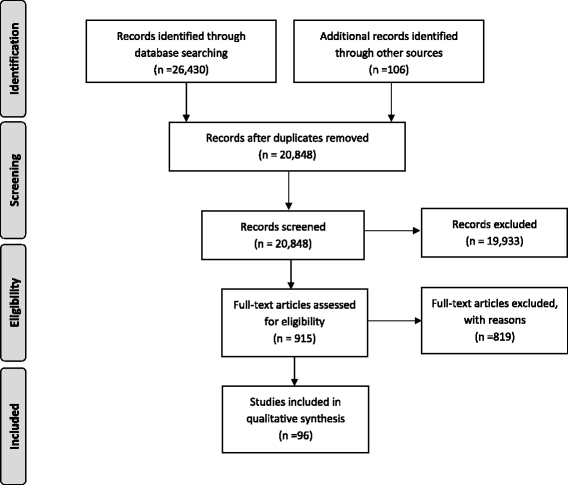Systematic review of the relationships between physical activity and health indicators in the early years (0-4 years)
- PMID: 29219090
- PMCID: PMC5753397
- DOI: 10.1186/s12889-017-4860-0
Systematic review of the relationships between physical activity and health indicators in the early years (0-4 years)
Erratum in
-
Correction to: Systematic review of the relationships between physical activity and health indicators in the early years (0-4 years).BMC Public Health. 2017 Dec 29;17(1):985. doi: 10.1186/s12889-017-4981-5. BMC Public Health. 2017. PMID: 29287590 Free PMC article.
Abstract
Background: Given the rapid development during the early years (0-4 years), an understanding of the health implications of physical activity is needed. The purpose of this systematic review was to examine the relationships between objectively and subjectively measured physical activity and health indicators in the early years.
Methods: Electronic databases were originally searched in April, 2016. Included studies needed to be peer-reviewed, written in English or French, and meet a priori study criteria. The population was apparently healthy children aged 1 month to 59.99 months/4.99 years. The intervention/exposure was objectively and subjectively measured physical activity. The comparator was various volumes, durations, frequencies, patterns, types, and intensities of physical activity. The outcomes were health indicators ranked as critical (adiposity, motor development, psychosocial health, cognitive development, fitness) and important (bone and skeletal health, cardiometabolic health, and risks/harm). The Grading of Recommendations Assessment, Development, and Evaluation (GRADE) framework was used to assess the quality of evidence for each health indicator by each study design.
Results: Ninety-six studies representing 71,291 unique participants from 36 countries were included. Physical activity interventions were consistently (>60% of studies) associated with improved motor and cognitive development, and psychosocial and cardiometabolic health. Across observational studies, physical activity was consistently associated with favourable motor development, fitness, and bone and skeletal health. For intensity, light- and moderate-intensity physical activity were not consistently associated with any health indicators, whereas moderate- to vigorous-intensity, vigorous-intensity, and total physical activity were consistently favourably associated with multiple health indicators. Across study designs, consistent favourable associations with health indicators were observed for a variety of types of physical activity, including active play, aerobic, dance, prone position (infants; ≤1 year), and structured/organized. Apart from ≥30 min/day of the prone position for infants, the most favourable frequency and duration of physical activity was unclear. However, more physical activity appeared better for health. Evidence ranged from "very low" to "high" quality.
Conclusions: Specific types of physical activity, total physical activity, and physical activity of at least moderate- to vigorous-intensity were consistently favourably associated with multiple health indicators. The majority of evidence was in preschool-aged children (3-4 years). Findings will inform evidence-based guidelines.
Keywords: Adiposity; Cardiometabolic health; Cognitive development; Early years; Fitness; Infants; Injury; Motor development; Physical activity; Preschoolers; Prone position; Psychosocial health; Skeletal health; Toddlers.
Conflict of interest statement
Ethics approval and consent to participate
Not applicable.
Consent for publication
Not applicable.
Competing interests
The authors declare that they have no competing interests.
Publisher’s Note
Springer Nature remains neutral with regard to jurisdictional claims in published maps and institutional affiliations.
Figures
Similar articles
-
Systematic review of the relationships between sedentary behaviour and health indicators in the early years (0-4 years).BMC Public Health. 2017 Nov 20;17(Suppl 5):868. doi: 10.1186/s12889-017-4849-8. BMC Public Health. 2017. PMID: 29219092 Free PMC article. Review.
-
Systematic review of the relationships between sleep duration and health indicators in the early years (0-4 years).BMC Public Health. 2017 Nov 20;17(Suppl 5):855. doi: 10.1186/s12889-017-4850-2. BMC Public Health. 2017. PMID: 29219078 Free PMC article. Review.
-
Systematic review of the relationships between combinations of movement behaviours and health indicators in the early years (0-4 years).BMC Public Health. 2017 Nov 20;17(Suppl 5):849. doi: 10.1186/s12889-017-4851-1. BMC Public Health. 2017. PMID: 29219071 Free PMC article. Review.
-
Systematic review of the relationships between objectively measured physical activity and health indicators in school-aged children and youth.Appl Physiol Nutr Metab. 2016 Jun;41(6 Suppl 3):S197-239. doi: 10.1139/apnm-2015-0663. Appl Physiol Nutr Metab. 2016. PMID: 27306431 Review.
-
Combinations of physical activity, sedentary behaviour and sleep: relationships with health indicators in school-aged children and youth.Appl Physiol Nutr Metab. 2016 Jun;41(6 Suppl 3):S283-93. doi: 10.1139/apnm-2015-0626. Appl Physiol Nutr Metab. 2016. PMID: 27306434 Review.
Cited by
-
Effectiveness of a parent-focused intervention targeting 24-hour movement behaviours in preschool-aged children: a randomised controlled trial.Int J Behav Nutr Phys Act. 2024 Sep 9;21(1):98. doi: 10.1186/s12966-024-01650-2. Int J Behav Nutr Phys Act. 2024. PMID: 39252110 Free PMC article. Clinical Trial.
-
Effects of a Nine-Month Physical Activity Intervention on Morphological Characteristics and Motor and Cognitive Skills of Preschool Children.Int J Environ Res Public Health. 2020 Sep 11;17(18):6609. doi: 10.3390/ijerph17186609. Int J Environ Res Public Health. 2020. PMID: 32932771 Free PMC article. Clinical Trial.
-
Physical Activity Levels among Preschool-Aged Children in Family Child Care Homes: A Comparison between Hispanic and Non-Hispanic Children Using Accelerometry.Children (Basel). 2021 Apr 28;8(5):349. doi: 10.3390/children8050349. Children (Basel). 2021. PMID: 33924912 Free PMC article.
-
Active Commuting to School among Spanish Preschool Children: A Temporal Change Study between 2013 and 2017.Children (Basel). 2023 Dec 20;11(1):3. doi: 10.3390/children11010003. Children (Basel). 2023. PMID: 38275424 Free PMC article.
-
Results from the Australian 2022 Report Card on physical activity for children and young people.J Exerc Sci Fit. 2023 Jan;21(1):83-87. doi: 10.1016/j.jesf.2022.10.006. Epub 2022 Nov 4. J Exerc Sci Fit. 2023. PMID: 36408206 Free PMC article.
References
-
- Poitras VJ, Gray CE, Borghese MM, Carson V, Chaput JP, Janssen I, et al. Systematic review of the relationships between objectively measured physical activity and health indicators in school-aged children and youth. Appl Physiol Nutr Metab. 2016;41(6):S197–S239. doi: 10.1139/apnm-2015-0663. - DOI - PubMed
-
- US Department of Health and Human Services. Physical activity guidelines for Americans. 2008. https://health.gov/paguidelines/guidelines/. Accessed 4 Jan 2016.
-
- World Health Organization. Global recommendations on physical activity for health. World Health Organization, Geneva, Switzerland. 2010. http://www.who.int/dietphysicalactivity/publications/9789241599979/en/. Accessed 4 Jan 2016.
Publication types
MeSH terms
LinkOut - more resources
Full Text Sources
Other Literature Sources
Medical
Miscellaneous



